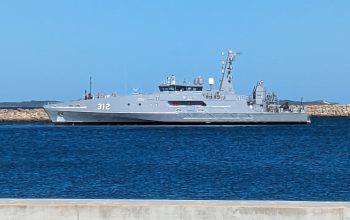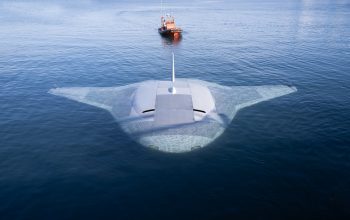USS Marinette (LCS-25) will be a Freedom-class littoral combat ship of the United States Navy. She will be the first commissioned ship, and second overall in naval service to be named after Marinette, Wisconsin (the place where it was built), the other being Marinette (YTB-791), a Natick-class large fleet tugboat. Marinette Marine was awarded the contract to build the ship on 31 March 2016 at their shipyard in Marinette, Wisconsin. A fast, agile surface combatant, the LCS provides the required war fighting capabilities and operational flexibility to execute a variety of missions in areas such as mine warfare, anti-submarine warfare and surface warfare.
The ship will be built with modular design incorporating mission packages that can be changed out quickly as combat needs change in a region. These mission packages are supported by detachments that deploy both manned and unmanned vehicles, and sensors, in support of mine, undersea, and surface warfare missions. The Freedom class was proposed by a consortium formed by Lockheed Martin as “prime contractor” and by Fincantieri (project) through the subsidiary Marinette Marine (manufacturer) as a contender for a fleet of small, multipurpose warships to operate in the littoral zone. The Freedom class is one of two classes of the littoral combat ship program, built for the United States Navy.

The ship is a semiplaning steel monohull with an aluminum superstructure. It is 377 ft (115 m) in length, displaces 3,500 metric tons (3,400 long tons), and can achieve 47 kn (87 km/h; 54 mph). The design incorporates a large, reconfigurable seaframe to allow rapidly interchangeable mission modules, a flight deck with integrated helicopter launch, recovery and handling system, and the capability to launch and recover boats from both the stern and side. The flight deck is one and a half times larger than that of a standard surface ship, and uses a Trigon traversing system to move helicopters in and out of the hangar.
The fore deck has a modular weapons zone which can be used for a 57 mm gun turret or missile launcher. A Rolling Airframe Missile launcher is mounted above the hangar for short-range defense against aircraft and cruise missiles, and .50-caliber gun mounts are provided topside. The Fleet-class unmanned surface vessel is designed for operations from Freedom-variant ships. The core crew is 40 sailors, usually joined by a mission package crew and an aviation detachment for a total crew around 75. Automation allows a reduced crew, which greatly reduces operating costs, but workload can still be “gruelling”. During testing of the class lead, two ship’s companies will rotate on four-month assignments.


























